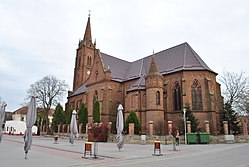Pecica
|
Pecica Pécska |
||
|---|---|---|
| Town | ||

The urban ensemble
|
||
|
||
| Location of Pecica | ||
| Coordinates: 46°10′12″N 21°4′12″E / 46.17000°N 21.07000°ECoordinates: 46°10′12″N 21°4′12″E / 46.17000°N 21.07000°E | ||
| Country |
|
|
| County | Arad County | |
| Status | Town | |
| Government | ||
| • Mayor | Petru Antal (Democratic Liberal Party) | |
| Area | ||
| • Total | 237.17 km2 (91.57 sq mi) | |
| Population (2002) | ||
| • Total | 13,024 | |
| Time zone | EET (UTC+2) | |
| • Summer (DST) | EEST (UTC+3) | |
| Climate | Cfb | |
| Website | http://www.pecica.ro/ | |
Pecica (Romanian pronunciation: [ˈpet͡ʃʲ.ka]; Hungarian: Pécska; German: Petschka; Serbian: Печка/Pečka) is a town in Arad County, Romania. In ancient times it was a Dacian fortress called Ziridava and today it is an important archeological site. Situated at 25 kilometres (16 mi) from Arad, it was declared a town in 2004. Its administrative territory extends into the Arad Plateau. The town administers three villages: Bodrogu Vechi (Óbodrog), Sederhat (Szederhát) and Turnu (Tornya).
According to the census of 2011 the population of the town counts 11885 inhabitants. The ethnic composition is as follows: 62% Romanians, 27.98% Hungarians, 8.6% Roma, 0.33% Slovaks, 0.36% Serbs and 0.7% are of other or undeclared nationalities.
Due to the abundance of archaeological finds of the zone an important historic period known as the Periam-Pecica culture was named after the settlement. The history of the localities Pecica, Bodrogu Vechi, Sederhat and Turnu is closely connected with the events making highly memorable the entire zone of the Arad Plateau.
The first mention in documents of the locality dates back to 1335 when it was known as Petk. Sederhat was registered only in 1913, Turnu in 1333 under the name of Mok, while Bodrogu Vechi in 1422 under the name of Bodruch. It has a complex political history with periods of Ottoman rule, periods of Habsburg Monarchy, Kingdom of Hungary and Kingdom of Romania. After the Austro-Hungarian Compromise of 1867, it became part of the Kingdom of Hungary within Austria-Hungary up until the Treaty of Trianon. Since then the town has been part of Romania.
...
Wikipedia


